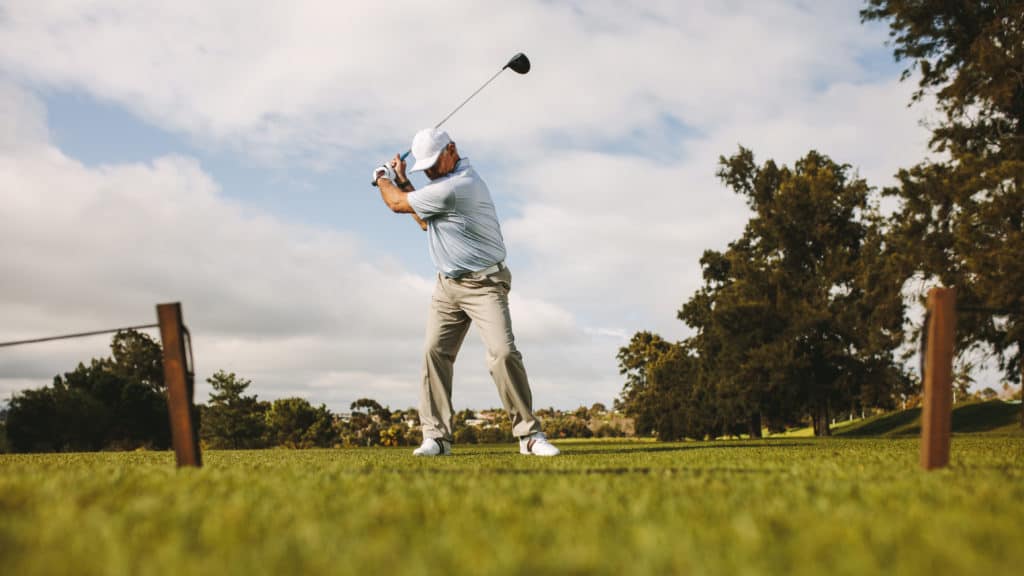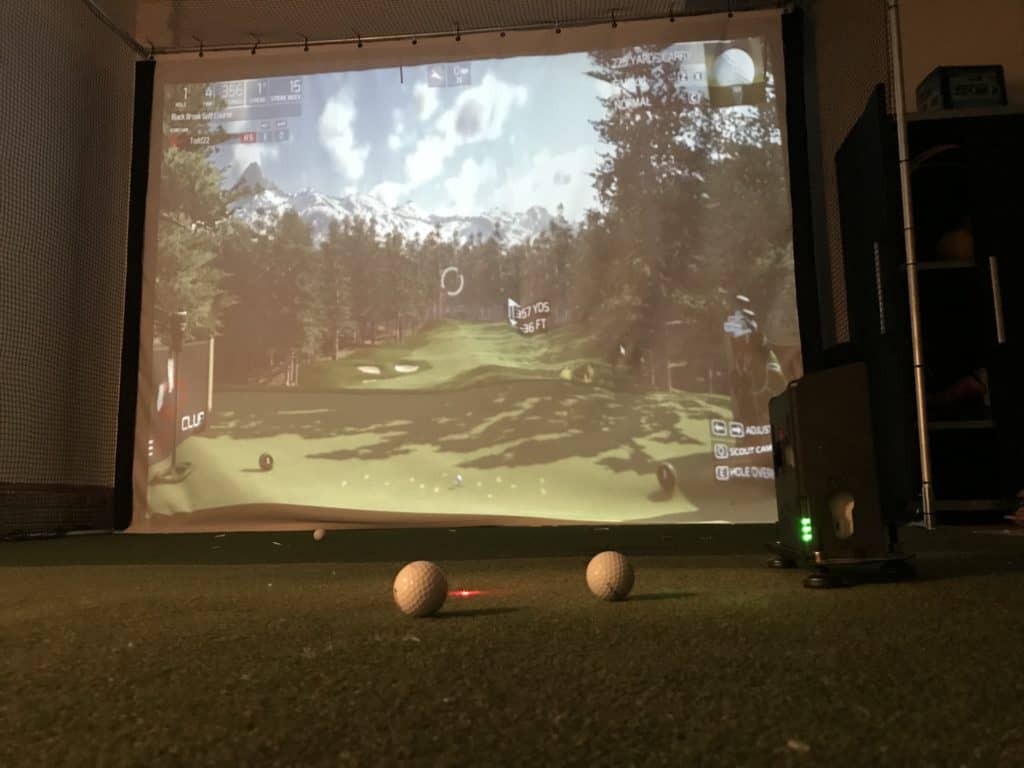In my journey with my golf swing, I have often asked the question of whether I should have a flat swing or a more upright golf swing.
There seems to be golfers on the PGA Tour that use both, but what is best for my game?
Have you been making swing changes or have seen your swing on video and are asking the same question?
Below, I will take you through the pros and cons and help you make this decision once and for all for your golf swing.
I set out to learn as much as possible about the flat swing in golf and the pros and cons that it would bring to my game.
I have come to the conclusion that either swing will work: a flat swing or an upright swing.
I have learned a lot from George Gankas and that golf is a game of matchups. What we do on our backswing will impact our down swing.
My goal is to create a swing that allows me to be most consistent and strike the ball solid every time I play a round of golf.
I have found the rotation in the golf swing to be vital. At one point, I was too steep in my backswing and relied on the timing of my hands, which often had me fighting a hook.
Now I am on a better plane, rotating through the shot, and allow the club to whip through the hitting zone by rotation and not by flipping of the hands. So my swing is now flatter, but not flat.

Pros and Cons of a Flat Swing?
Pros
- A golfer is already in a shallow position
- Does not take manipulation in the downswing
- Easier to stay on plane
- Able to rotate through the shot better without manipulation
- May help the golfer stay to the inside
Cons
- Can be difficult out of the rough
- Could cause the golfer to swing out of the top
- Golfer could get stuck in downswing
Pro #1: A golfer is already in a shallow position
One of the keys to any golf swing is being shallow enough in the downswing to maximize contact, speed, and launch angle.
When a swing gets too steep, it could lead to disaster as the golfer often has to early extend, stall of flip at the ball as a result. Golf is a difficult game, but when you are too steep the golfer could really struggle with making solid, compression ball contact that sends the ball flying.
I have also seen many amateurs lift the club on their backswing, which makes them steep and then come out of the top causing the dreaded slice.
The flatter swing will allow the golf to continue to swing in a circle and hit the ball on the way out, promoting more of a draw swing versus an over the top slice swing.
Pro #2: Does not take manipulation in the downswing
Golfers with a steep backswing are still able to shallow it out, but it takes the hands falling down below the original backswing plane in order to shallow the ball.
When the hands and arms stay flatter on the backswing, the golfer is able to simply turn and rotate through the ball and keep the club on a shallow plane.
Some golfers, think Matt Wolff prefer that bit of a loop in the swing where the club is steep and then shallow it out. For the golfer who might only play once or twice a week this manipulation of the club and shallowing out method might be difficult to repeat when you aren’t practicing every day!
See Matt Wolff get shallow:
Pro #3: Easier to stay on plane
Keeping the plane simple is recommended for the golfer who doens’t have a ton of time to practice. Taking the arms back where the left arm is in line with the shoulder plan will keep the swing simple.
As someone with more of a steep swing, I find myself fighting to get the club shallow enough to make solid contact when I am struggling.
The golf swing that is very easy to repeat and keeps the club flat is the stack and tilt swing. This swing promotes the hands coming through the right bicep and keeping the club on a flatter plane.
Pro #4: Able to rotate through the shot better without manipulation
If you get a deep enough turn with a flat plane, the golfer is able to rotate hard through the swing and utilize the bigger muscles to control the club face.
Golfers who are too steep, have to drop the club down and then rotate to be able to stay on the plane and keep the body from stalling and the hands flipping.
One of the biggest swing faults amongst many amateurs is not getting deep enough on the back swing (lack of shoulder turn) and then stalling or early extension in the downswing. This leads to the hands flipping and relying on the timing of the golf swing.
You might be amazed at the extra speed you are able to generate from properly rotating through the golf swing. As the hips and chest clear the club is able to really generate some speed at impact. If you are flipping early, you are losing your speed too early in the downswing.
If you ever wondered why you aren’t consistent this may be the number one reason! Check out our post here on the 11 top reasons why a golf may be inconsistent!
Pro #5: May help the golfer stay to the inside
Of the 20 plus handicap golfers that i have seen, many struggle with the over the top move. They lift their arms up, lack turn and depth and then cut across the ball. Flattening out the swing will encourage you to hit the ball from the inside and start to create a push draw.
You have to be careful not to get too flat and then come ove the top (see cons below)
Con #1: Can be difficult out of the rough
In really thick rough the flatter swings may struggle to be steep enough to make solid contact with the ball.
However, maybe you are consistent enough to keep it out of the steep rough by keeping the swing flatter and utilizing the rotation to stabilize the club face.
Con #2: Could cause the golfer to swing out of the top
As mentioned above the flatter swing could result in the opposite action on the downswing and the golfer could have a slight over the top move from this flat position.
Many of the golfers that have steeper arms and hands int he swing, like that feel of dropping into the slot and then rotation through the shot. Be careful to have enough movement in the body while keep the hands back.
This will help reduce the over the top move.
Con #3: Golfer could get stuck in downswing
As the golfer starts the downswing if the hands are too flat and then get flatter while the body starts to turn, you may find that you are “getting stuck.”
This is a position where the body has cleared, the hands are stuck behind you and it often takes perfect timing that day to hit the ball straight.
Tiger Woods struggled with this position early in career and worked with Butch Harmon on freezer drills to help time up the downswing and the movements between his arm and his body.
Next Steps
Step 1: Record Your Swing
Grab your smart phone and have someone take a video of you from the side and from down the line. Look at where the club passes through your right bicep. Are your hands above this (steep), right on, or below it (flat).
The goal doesn’t have to be to get into the perfect position as there really is none. Instead, understand the possible matchups and problems that exist and work on drils to avoid these flaws in your golf swing.
When you get out on the course, you can rehearse a certain movement, but when it is time to hit the shot, make sure you are more target focused.
Step 2: Compare to a Pro Golfer
What golfer below would you compare your swing most to? Check out the videos below and see where you fall, steep or more flat?
Steep Swing 1: Jack Nicklaus
Steep Swing 2: Justin Thomas
Flat Swing 1: Matt Kuchar
Flat Swing 2: Rickie Fowler
Step 3: Measure Your Swing
Now that you have seen your swing on your phone, find a way to measure your swing by getting some numbers from a launch monitor. Golf is a game of matchups.
Maybe you don’t like the exact look for your swing, but if you are hitting the ball from the inside and can rely on a stock shot, then stick with what you are doing.
If you are flipping, stalling, early extending and your numbers are off as well, then it might be time to check out some online instructors that can help improve your game.
Golf launch monitors run from $500 to $18,000. Here are some viable options that might be worth adding to your technology tools to improve your game!
Knowing numbers like spin rate, ball speed, spin axis and other key information is vital to your growth. Sharing these numbers with your instructor can be helpful and help with equipment selection as well.
I would recommend one of the three launch monitors listed below:
I have started a journey through George Gankas membership site. Check out my review and follow my journey here.
Here is a list of golf instructors that we have reviewed:

Step 4: Practice Your Swing
The key to golf improvement is practice, pracitce, practice, but make sure you are practing the right things. I have found the recipe for me is to learn about the swing, see what I am doing in my swing (video), measure my swing through my SkyTrak, and then practice.
I have been able to do this in my golf simulator in my garage. I use this as my lab to experiment, drill and practice with the ultimate goal of improving my golf swing!
If you are interested in a golf simulator, check out these helpful links below:
I am an amateur golfer on a journey to get better, enjoy the game as often as possible and share my passion and knowledge with others. I have coached high school golfers at a high level and have a great passion for the game and want to give back. I enjoy learning about the golf swing and am currently studying to be a certified professional golf instructor. Join me in our journey to get better everyday.

